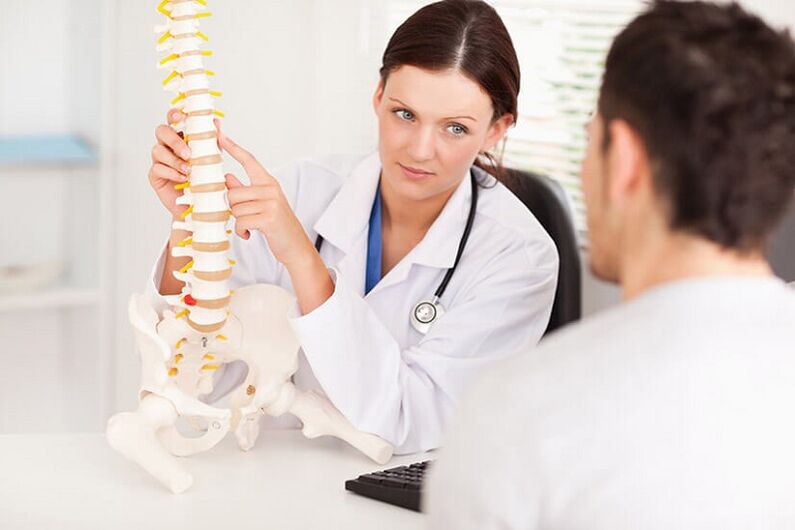The emergence of such a dangerous disease as osteochondrosis contributes to the development of inflammatory processes in the cartilage and bone tissues of the spine.

The causes of such a pathology can be a large number of factors. If not properly treated, this type of inflammation can lead to disability.
Osteochondrosis of the thoracic spine - what is it?
Osteochondrosis disease of the thoracic region is an injury to cartilage and bone tissue, which results in degenerative changes in the spine. The lack of correct and timely treatment very often leads to complete or partial destruction of the intervertebral discs.
This type of disease is very often accompanied by a large number of other types of disease. The peculiarity of osteochondrosis of the chest region is that the affected area is hidden by the bone tissue of the breast, which complicates the correct diagnosis of the disease and the risk of damage to organs located nearby.
To note!The structure of the human thoracic region is slightly different from that of the lumbar region, as it contains a greater number of intervertebral discs. However, they are much thinner than the others. Therefore, the destruction and damage to the spine in the chest area is much more difficult to heal, and the disease progresses much faster.
Causes of the disease
The onset of the disease of osteochondrosis of the thoracic region is a phenomenon that occurs much less frequently than the defeat of the cervical and lumbar vertebrae.
The following reasons may contribute to the appearance of an inflammatory process in the thoracic region:
- Disorders of any origin in the intervertebral discs.
- Intervertebral hernia.
- Inflammatory foci in cartilage tissue.
- Violation of the level of blood circulation in the tissues of the region of the spine.
- Excessive physical stress on the spine.
- Insufficient supply of useful minerals in the body.
- Passive lifestyle.
- Rachiocampsis.
- Injuries and bruises.
- Strength sports exercises.
- Frequent hypothermia.
- Frequent stressful situations and difficult working conditions.
The disease can develop due to a hereditary predisposition to the onset of symptoms.
Symptoms and signs
The development of osteochondrosis in the thoracic region has the following symptoms:
- The appearance of pain in the ribs.
- Discomfort when breathing.
- Sharp pain when bending and raising the arms.
- The appearance of a pulling pain between the shoulder blades, even when lying down.
- The appearance of swelling of numbness in the shoulder blades.
- Increased body temperature and chills.
- Burning sensation in the lower limbs.
- Violation of the normal functioning of the vascular system of the thoracic region.
At the first stages of development, the following signs of the onset of the disease can be observed:
- Frequent headaches.
- Nausea.
- Increase in body temperature.
- Painful sensations in the chest on waking in the morning.
- Dizziness.
- Weakness.
- Painful sensations with sudden breathing and exhalation.
To note!Very often the disease can be confused with inflammatory processes of internal organs, since the symptoms of development very often coincide. To confirm the diagnosis, it is necessary to undergo a special examination.
Actions required during an exacerbation

If the course of the disease is left without proper attention, exacerbations may occur, during which a person may experience symptoms of acute pain and lack of normal functioning of the body.
During exacerbations, the following actions are recommended:
- Observe bed rest.
- Adhere to a proper diet, which should contain a large number of foods that saturate the body with all vitamins and minerals.
- Contact a medical facility and take all medications.
- The use of funds for external treatment.
- If necessary, perform physiotherapy exercises.
- With the appointment of a doctor, the transition from exposure methods to physiotherapy
At the time of exacerbation of the disease, it is necessary to completely exclude various types of physical activity and stressful situations.
Treatment of osteochondrosis of the thoracic region

For treatment, the patient must undergo a special examination, which involves the delivery of the necessary tests and the passage of the procedure of radiography and tomography.
Only after receiving all the answers to the necessary tests, the doctor prescribes treatment including drugs, massage and physiotherapy exercises.
Medical treatment
Drug treatment of the disease includes the following directions - this is the elimination of pain, the arrest of the development of osteochondrosis, the elimination of the inflammatory process.
To reduce pain, pain relievers and antispasmodics are prescribed.
To restore damaged tissue, the use of glucosamine and chondroitin is prescribed. In addition, the patient should increase the intake of the necessary vitamins in the body, if food products are not enough, special vitamin complexes are recommended.
Good to know!In order to retain the necessary fluid in the intervertebral discs, a special agent must be used. To relieve the inflammatory process, it is recommended to use nonsteroidal anti-inflammatory drugs, which the attending physician selects individually for each case.
Physiotherapy
The use of physiotherapy exercises is prescribed only after the elimination of pain symptoms, the inflammatory process decreases. Carrying out therapeutic exercises is carried out strictly under the supervision of specialists to avoid the appearance of complications.
The purpose of exercise is to eliminate muscle spasms and increase blood flow instead of damage, due to which the inflammatory process decreases and damaged cells begin to regenerate on their own.
Massage
The use of massage for osteochondrosis is prescribed depending on the degree of development of the disease. For acute symptoms, light stroking and rubbing are allowed, without the use of forceful methods.
After the painful symptoms are eliminated, a drainage massage is applied, which improves blood circulation and initiates the natural process of cell repair.
To note!For massage, it is recommended to use special gels or essential oils that reduce inflammation and improve the well-being of a person. It is not recommended to perform the massage yourself, you need to contact a specialist.
Manual therapy
Manual therapy for osteochondrosis has the following features of the effect on the focus of the lesion:
- The specialist warms up the tense muscle tissue.
- Slow stretching of muscle tissue is performed, which relieves the spasm.
- The patient receives acupressure massages which eliminate inflammation and improve blood circulation.
- Special movements are performed to restore the work of the damaged area of the spine.
To note!After such sessions, the patient notices a decrease in pain and an improvement in the condition of the whole body.
Prevention of osteochondrosis of the thoracic region
To avoid the development of the disease, experts recommend adhering to the following prevention rules:
- To avoid hypothermia of the body, in the event of such a situation, it is recommended to take a hot bath.
- Perform standard physical exercises that increase the flexibility and plasticity of the spine.
- Avoid standing in awkward positions for a long time, lead an active lifestyle.
- Regularly renew the supply of vitamins and minerals in the body.
- Avoid prolonged physical exertion on the spine.
- Avoid lifting weights.
- Avoid slouching, watch your posture.
By following simple rules, a person can avoid unpleasant symptoms and long-term treatment.
Osteochondrosis disease of the thoracic region is a fairly complex type of inflammatory process that requires complex therapy.
Good to know!This type of disease cannot be cured on its own, therefore, when the first symptoms appear, you should contact a medical institution for a diagnosis. Based on the answers, the doctor will individually select the necessary method to eliminate the problem.































